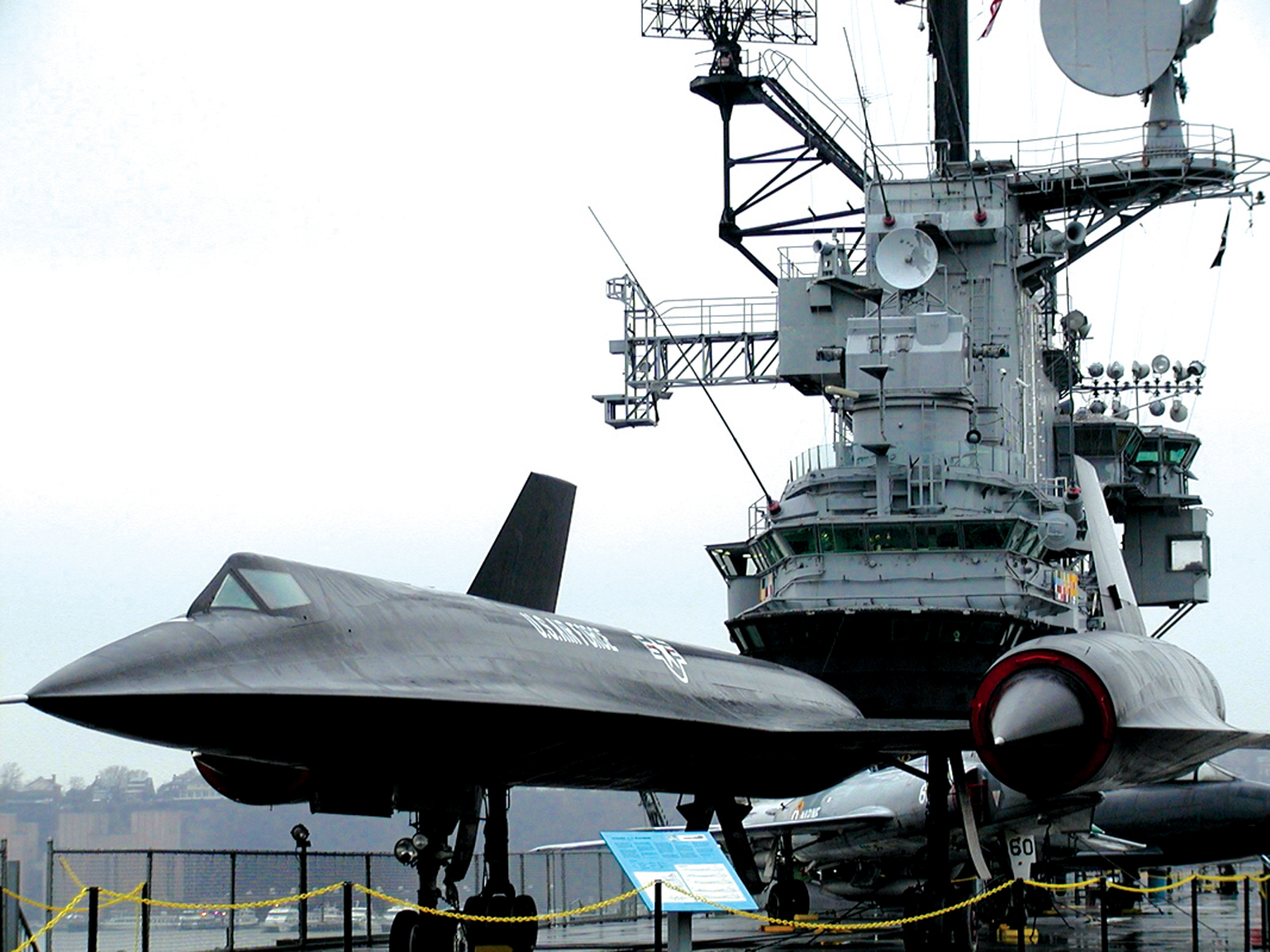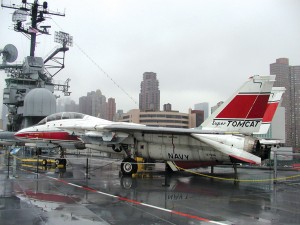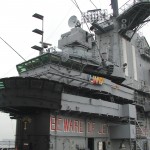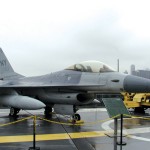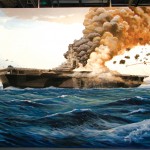By Henry M. Holden,
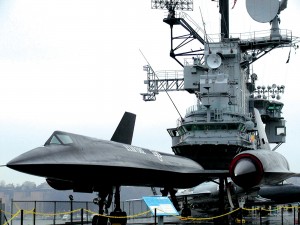
An SR-71 on loan is poised quietly beneath the Island Bridge. This A-12 Blackbird spy plane will probably never fly again.
Carrier aviation helped win the war in the Pacific, and has been the backbone of America’s defense, yet few memorials honor this segment of our history. New York City has such a memorial, and it’s the largest floating memorial in the world. Berthed at Pier 86, on the Hudson River, is the 40,000-ton veteran of three wars, the aircraft carrier USS Intrepid (CV-11).
The United States launched this carrier, the fourth ship to bear the name Intrepid, 17 months after the Japanese attacked Pearl Harbor. On Dec. 3, 1943, Intrepid left Norfolk to join the Central Pacific Forces. It cost $44 million to build, and carried 360 officers and 3,008 enlisted men.
Intrepid was a member of the 24 “fast carriers” in the Essex Class, the heart of the World War II Pacific fleet. Four of these carriers, including Intrepid, survive as museums. The Intrepid Sea-Air-Space Museum covers 150,000 square feet, including the hangar, flight decks and island bridges. Several decks below, 200,000 square feet are being outfitted for future displays.
The Hangar Deck
A number of hands-on aircraft simulators can be found on the museum’s hangar deck. The first you come upon is the A-6E Intruder, which began life in 1963 as a two-seat, subsonic all-weather attack aircraft. There’s also an actual A-6 on the flight deck. The simplified computer simulations in the A-6 cockpit give users an understanding of the challenges a pilot must overcome to become carrier qualified.
The Allison and Howard Lutnick Theater shows the thrills of U.S. Navy carrier operations at sea, and prepares you for your day aboard Intrepid. The hangar deck contains four theme halls—Navy Hall, Intrepid Hall, Pioneers Hall and Technology Hall. They contain dramatic sound, light and visual presentations, which transport you into the daily bustle of an active carrier, both past and present.
Intrepid Hall presents one of the most impressive productions on the hangar deck tour. A movie displayed on the starboard bulkhead shows Intrepid during the days of World War II, at the high point of its career.
The carrier’s record in World War II includes the invasion of the Marshall Islands, the raid on Truk in the Carolinas, Pelileu in the Palau Group, reentry into the Philippines, and a savage series of kamikaze battles around Okinawa. It was responsible for sinking 80 enemy ships and destroying more than 800 aircraft. The Island Bridge proudly wears the battle ribbons of these victories.
The Intrepid took part in the largest battle in naval history, at Leyte Gulf. Her air group helped sink the Japanese super battleship Masashi, and the aircraft carrier Zuikaku. Six months later, her aircraft sank the super battleship Yamato.
During World War II, kamikaze aircraft hit Intrepid four times, earning her the title of “The Navy’s most frequently hit carrier.” In October 1944, a Japanese kamikaze aircraft attempted to crash into the carrier’s flight deck. A portside gun, manned by 22 black sailors, faced down the incoming airplane, and blew it up just yards from the ship. Part of the plane’s wing flew into the gun emplacement, killing 10 men, and wounding eight. (Fifty years later, President Ronald Reagan awarded the Navy Cross to the lone remaining survivor.)
The following month, Intrepid took two kamikaze hits. One hit directly on the hangar deck, where men were refueling and rearming Navy Hellcats. The hangar deck exploded into flames, creating chaos. The two kamikaze hits that month took the lives of 69 men. With film and visual aids, it’s not hard to visualize being there, and you realize you’re standing on the spot where these heroes fell. More than 100 men were lost in torpedo and kamikaze attacks on the ship, and 200 aviators died in action over enemy targets.
Intrepid was completely modernized and given a new angled flight deck in 1958. It remained an attack carrier until 1962, when it became an antisubmarine warfare carrier. In May 1962, Intrepid became the primary recovery vessel for NASA, picking up Scott Carpenter and his Mercury capsule, Aurora 7. Later, Intrepid recovered astronauts Gus Grissom and John Young in the Gemini spacecraft Molly Brown. In Technology Hall, a superb exhibit, Mission Control, describes these and other recoveries.
Various presentations provide a comprehensive look at the space program over the years, and a special section is devoted to the shuttle program. Across from Mission Control is Space Flight Theater, where you can enjoy a film about the space program.
Intrepid also served three tours of duty in Vietnam, notably hitting significant targets while deployed in the Gulf of Tonkin. Throughout the hangar deck are aircraft that wrote the colorful history of this fighting ship, along with the story of naval aviation and its accomplishments.
In 1978, retired Admiral Zachary Fisher and his wife Elizabeth found Intrepid in a scrap yard waiting for its final demise. They spent $24 million of their own money, launching a campaign to save the mighty warship. In 1982, Intrepid was moved to New York City and opened as a museum.
The Flight Zone
Ever wonder what it would be like to fly an F/A 18 Hornet? The Flight Zone is a place where aspiring pilots of all ages can earn their wings without leaving the ground. In the G-Force Encounter, two G-Force simulators provide computer-controlled full motion, with yaw, pitch and roll actuators moving the hydraulically suspended cockpit. Outside movement is displayed on a 58-inch projection screen that fills the cockpit’s interior. You can grab the controls and fly a loop-de-loop, or jink your way through mountainous ravines, with realistic G-Force experience.
A surprise during the simulated flight may result in a Mayday. This one is for only the adventurous.
The “4-D Experience” is an unusual sim. Once you put on the special polarized glasses, you’ll experience flight simulation that will rock and roll, and pitch you during a six-minute assault on all your senses. With powerful blasting actuators under your seat, you’ll experience a near fourth dimension of thrills, as wind and mists channel through the cabin.
The Flight Deck
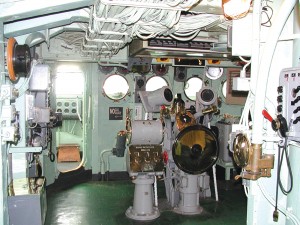
On the Navigation Bridge, visitors can learn how the crew of Intrepid would navigate the oceans in any weather, day or night.
On the flight deck, visitors have a panoramic view of the New York City and New Jersey skylines. After WWII, a 1,000-foot angled concrete runway replaced the original wooden flight deck. The catapults are quiet now, the blast deflectors are down, and the air is filled with only a stiff breeze off the Hudson River. If you listen carefully, the wind may still carry the whine of jet engines and the roar of those Hellcat propellers that once echoed across the flight deck.
Perched quietly on the flight deck are some 22 historic and contemporary aircraft, most of which carried squadron designations of Intrepid. You may notice a few incongruities on the deck; A MiG 21, an F-16 and a Royal Navy Supermarine Scimitar F-1, which never landed on the carrier’s deck, are displayed as examples of types. One glaring incongruity is just below the Island Bridge; on loan from the Air Force is an SR-71 Blackbird. Capable of speeds in excess of Mach 3, in reality it couldn’t land or takeoff from this carrier’s flight deck.
After 32 years in airline service, British Airways’ Concorde fleet was retired, and one of the Concordes, G-BOAD radio call sign Alpha Delta, found a permanent home at the Intrepid Sea-Air-Space Museum. On Feb. 7, 1996, Alpha Delta made the fastest Atlantic crossing of a Concorde, taking just 2 hours, 52 minutes and 59 seconds. During her career, the aircraft flew 23,397 hours, made 8,406 landings and underwent 7,010 supersonic cycles. Her final flight took place on Nov. 10, 2003. The aircraft was de-registered on May 4, 2004, and on June 26, 2004, went on permanent display at the museum.
From the flight deck, you can visit the Island Command Bridges. Here you can see firsthand the intricacies that go into operating an aircraft carrier, and the launching and recovering of aircraft. Because this is still an operational ship, you’re asked not to touch the levers and instruments.
Sept. 11
Intrepid played an important role after the September 11 terrorist attack in New York City. For weeks, it served as temporary field headquarters for 750 FBI agents, who were investigating the attack on the World Trade Center towers. Intrepid has several exhibits commemorating the heroes and victims of that attack.
The WTC exhibits are built around a 17-foot-long by 10 foot-high mural of the New York City skyline, as it looked before the attacks. Smaller exhibits display ground zero debris and artifacts. One contains a charred window frame from American Airlines Flight 11. Another has recovered debris—a crushed laptop, pulverized concrete, steel girders and scraps of office paper. Another exhibit displays some unpublished transparencies, taken at ground zero before, during and after the collapse of the WTC towers.
The most dramatic exhibit is a 10-foot tall replica of the Statue of Liberty, which mysteriously appeared in front of the firehouse on 48th Street and 8th Avenue in Manhattan. This house lost 15 men on 9/11. The statue soon became an urban artifact, as people from all over the world decorated it with flags, notes and medallions, as well as police and fire department patches and badges. Three life-sized figures, dressed in uniforms and equipment actually worn on 9/11, honor the rescuers, their sacrifice and their successful rescue of more than 25,000 people.
The Intrepid Sea-Air-Space Museum attracts more than 600,000 visitors annually. Located at the foot of West 46th Street and 12th Avenue, alongside the destroyer Edson, the museum is easy to reach. There’s nearby parking, and any one of three cross-town buses in midtown will drop you right in front of Pier 86.
Visitors can browse a well-stocked gift/book shop and visit two snack bars, one of which is located on the third deck, in the actual mess deck of the old carrier. Allow yourself a full day to see everything the museum has to offer, and don’t forget your camera.
For hours and other information, call 212-245-0072, or visit [http://www.intrepidmuseum.org].
- Battle ribbons are proudly displayed on the Island Bridge.
- Flags placed at Ground Zero after the attacks of 9/11 now adorn this replica of the Statue of Liberty, in tribute to the heroes of that day.
- A plaque in front of this F-16 commemorates the site where 22 black sailors staved off a kamikaze attack.
- A full wall mural depicts Intrepid in life-and-death combat.
- A Royal Navy Supermarine Scimitar F-1 rests on a rain-soaked flight deck.











